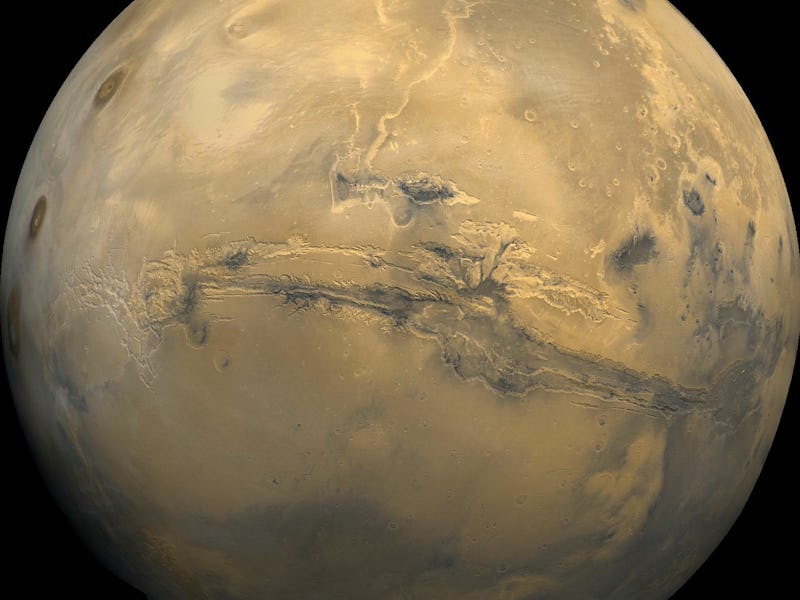'Naturally Occurring Batteries' on Mars May Hold Clues About Life's Origin
Changing the paradigm of biological life.

In the competition to be the biggest scientific cliché, right behind “The mitochondria is the powerhouse of the cell,” comes the phrase “Carbon is the building block of life.” But beyond the boundaries of Earth, life may be pieced together following a different set of rules.
The race is on to figure out what, exactly, those rules might be, and a new a study published today in Science Advances by the Carnegie Institution for Science, is starting to find answers. In the paper, researchers determined that Martian carbon was essentially made by a naturally-occurring battery. It’s a significant step forward in figuring out exactly how organic Martian compounds came about, since biology isn’t responsible. Led by senior staff scientist Andrew Steele, the group analyzed three Martian meteorites, Tissint, Nakhla, and NWA 1950, and showed that the organic compounds found inside match those of compounds previously found on Mars rover missions.
“It’s a scientific result using state-of-the-art instrumentation made on two planets, really,” Steele tells Inverse in an email.
What Meteorites Reveal
So why study meteorites? Of course, examining a rock here on Earth is a lot easier than making the 54.6 million kilometer (or 33.9 million mile) trek to the red planet (although that’s not stopping Elon Musk from taking on the challenge).
This is a mosaic image of Mars created from over 100 images taken by Viking Orbiters in the 1970s.
“Meteorites allow us to use state of the art instrumentation that could never fly to Mars such as Synchrotrons, transmission electron microscopes and secondary ion mass spectrometers,” says Steele. “This allows us to look at these samples at the nano-scale that was necessary to detect and understand the process as well as ensure what we were looking at was Martian.”
Steele’s group identified that these organic compounds were made by non-biological methods, classified as abiotic organic chemistry, in previous research from 2012. But by applying advanced techniques in microscopy and spectroscopy, the group delved into the formation process, eventually discovering that a naturally-occurring galvanic cell may be responsible for the creation of organic compounds. The minerals in Martian rocks, when met with a salty brine, formed energy in a process that’s not unlike Earth-bound efforts to remove CO2 from the atmosphere.
Carbon layers are found between the "tines" of the material. The texture is created when the volcanic minerals of the Martian rock interact with a salty brine and become the anode and cathode of a naturally occurring battery in a corrosion reaction, potentially creating enough energy to synthesize organic material.
“Basically, energy is released during the corrosion process that enables chemical reactions to happen,” Steele explains. “The hypothesis at the moment is there is enough energy to split water and the released hydrogen ions can react with CO2 dissolved in the brine to make organics.”
The process could translate to other locations with the right mix of igneous rock and brine, opening the door to understanding other solar bodies like Jupiter’s moon, Europa, or Saturn’s moon, Enceladus.
What Does Non-Biological Carbon Tell Us About Biological Life?
It sounds counterintuitive. Naturally occurring batteries? Non-biological organic material? Discoveries like these show us exactly how much we don’t know about what life on other planets could look like.
Steele’s research sets the stage for finding other positive measurements of life, as understanding basic non-life organic chemistry on Mars sets a reference point. Since we have no idea how Martian life could biochemically function, establishing some sort of baseline is crucial. What we find may also give us hints about Earth’s origins.
“The search for life in the solar system and beyond is also a search for our own origins, to give us a clue about the start of life on Earth,” says Steele.
Steele’s organic meteorite compounds also match those discovered by Curiosity earlier this year. To bridge the gap, in future work, the group hopes for clean samples to be returned from Mars to confirm their findings. It’s on you, InSight.